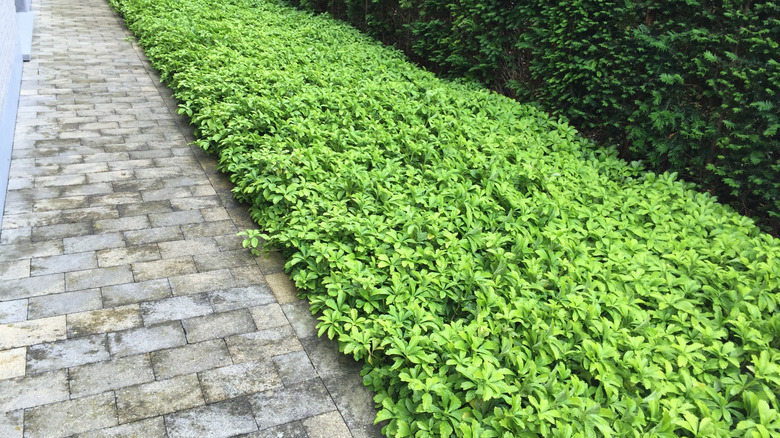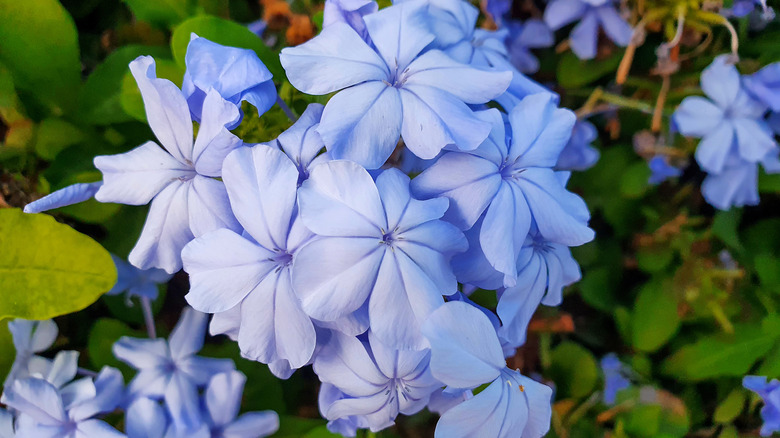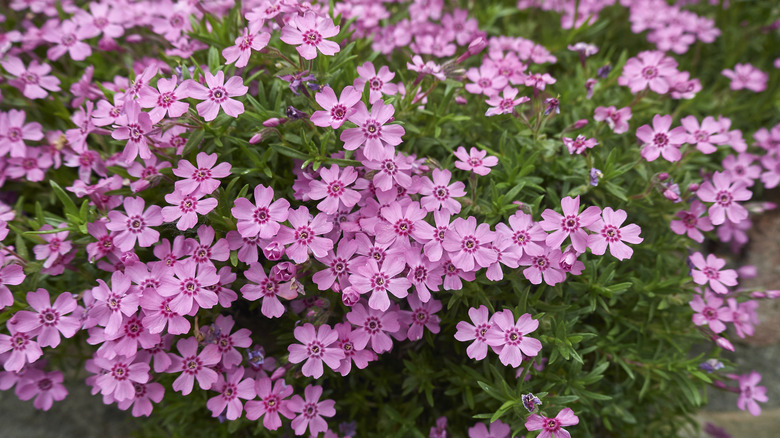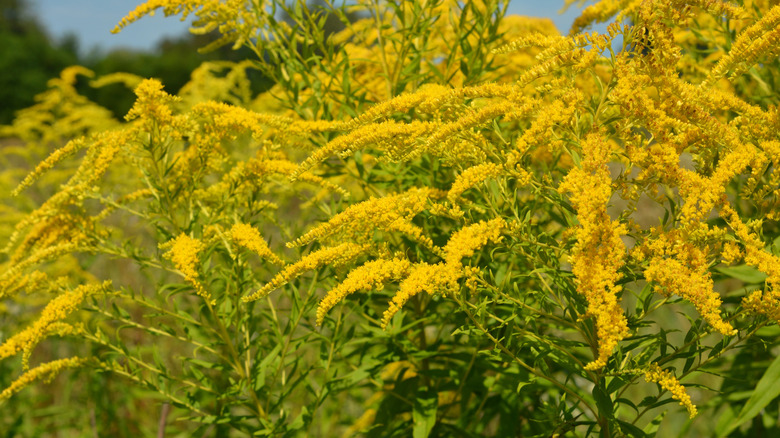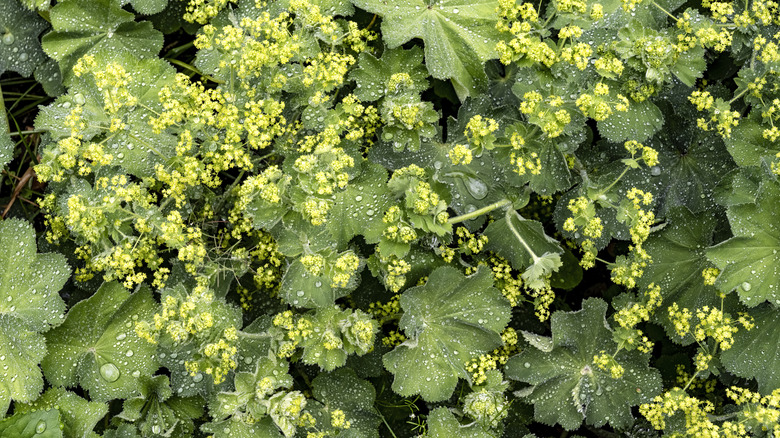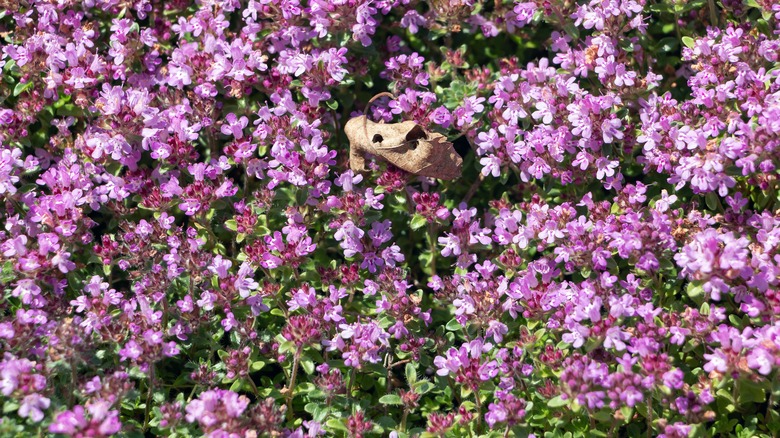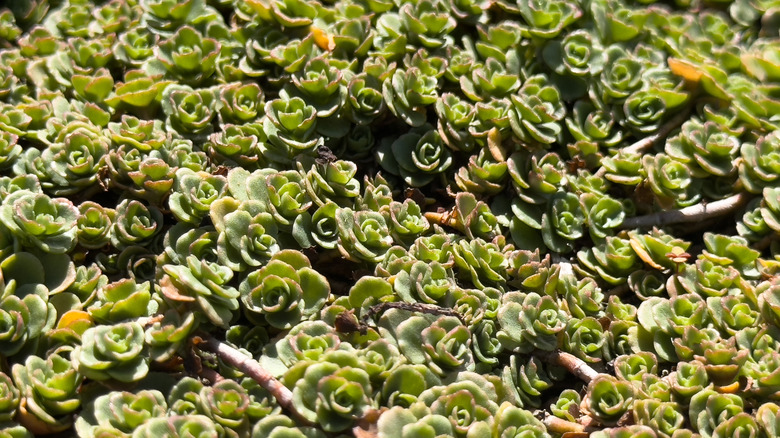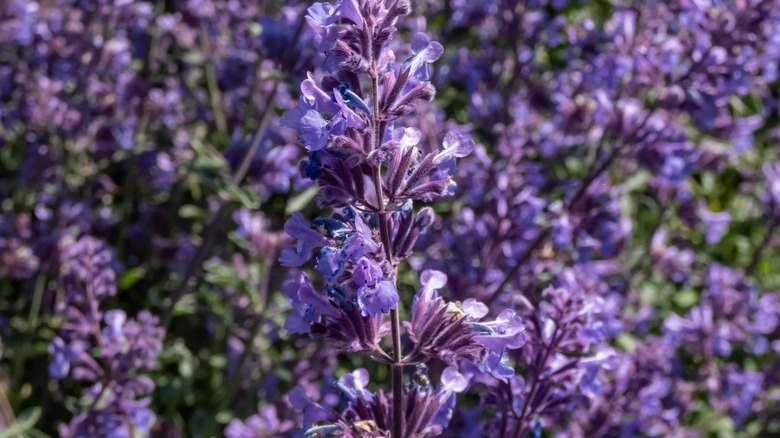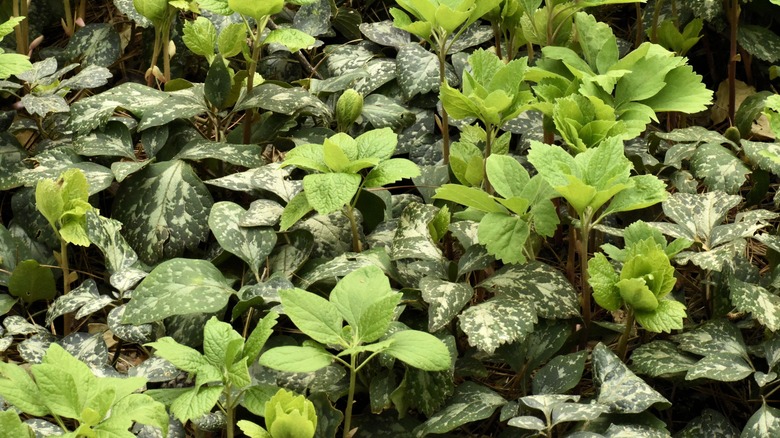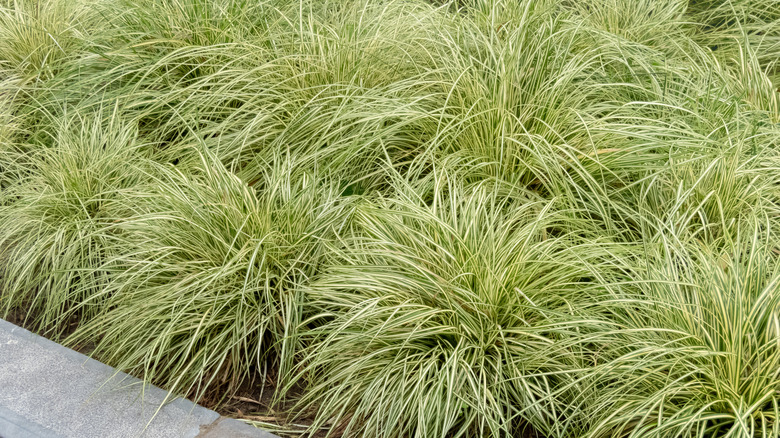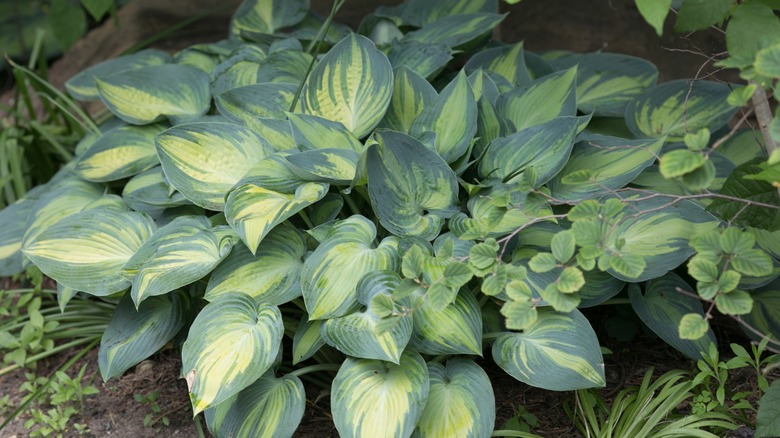11 Ground Covers You Can Plant To Help Choke Out Unwanted Weeds
We may receive a commission on purchases made from links.
It's astounding how stubborn weeds can be. Even if you pull them out carefully, they might return the next week, sometimes more aggressively. Although herbicides can solve this problem, they aren't ideal for your backyard birds or the environment. Moreover, it's tricky to treat areas full of broadleaf and grassy weeds, where creating a treatment program is complicated due to their differing lifecycles. Luckily, there's an easier way out of this predicament: ground covers. As low-profile perennials, they form a dense mat that deprives weeds of all wiggle room, along with their access to sunlight. After they're established, they reduce the need for weeding or chemical treatment.
To ensure success in this endeavor, utilize plants that grow relatively fast. But steer clear of invasive ground covers, including periwinkle, bugleweed, and ivy. If the chosen non-invasive variety is an assertive spreader, pair it with a plant that has a similar growth rate — this will help them check each other's spread. Alternatively, install edging and regularly deadhead their flowers to prevent takeover. If they aren't evergreen, make sure your selections green up early in spring, so they can compete with burgeoning weeds. Where budget permits, start ground covers from plugs rather than seeds. This will deny weeds the time to germinate. In case they succeed, you won't have to expend much energy differentiating between them and the perennial seedlings. With that said, use the following ground covers in your garden and yard to suppress weeds.
Plumbago inhibits weeds in dry, poor sites
If weeds have taken over a dry or a mostly infertile patch in your garden, you can muscle them out by growing plumbago or leadwort (Ceratostigma plumbaginoides), as it performs decently in such conditions. Standing 8 inches high and stretching 20 inches wide, it establishes an impenetrable mat that shades out weed seedlings, impeding their growth. Plumbago grows via rhizomes — modified stems that spread laterally underground and pop out new roots and shoots from their nodes. While this characteristic makes leadwort an aggressive spreader, it isn't considered invasive. Still, edge its boundaries or monitor for volunteers to be 100% sure, especially if they're planted in slightly moist soils.
Besides suppressing weeds, plumbago can beautify your yard. Spring foliage appears burgundy and is offset by blue tubular blooms. As you can imagine, hummingbirds and butterflies enjoy their nectar from summer through frost. In the fall, plumbago's foliage appears copperish-bronze until it dies back in the winter. As plumbago can be late to leaf out in the spring, it's ideal to retain the stems through the cold season. It's hardy in Zones 5 through 9 and is surprisingly adaptable to most light conditions. Its tolerance for dappled shade makes plumbago a strong ground cover contender under shade trees when grasses fail to survive. Otherwise, site it in full sun, but shade it in the afternoons during hot summers. It typically doesn't require deadheading or pruning. Since it doesn't grow taller than 1 foot, it can withstand some traffic.
Moss phlox quickly forms a dense, deer-resistant carpet that fights off weeds
In woodland settings, consider carpeting your ground with moss phlox (Phlox subulata). Not only is it deer-resistant, but this easy-to-grow ground cover can smother weeds in your yard and garden. Also known as creeping phlox, it sends out trailing stems from its main root system. They develop new roots when they touch the soil, enabling them to spread extensively. That way, the weeds are deprived of space to establish themselves, and so they're crowded out. Since moss phlox holds deeply onto the ground, it can also check erosion. By maturity, moss phlox stretches about 2 to 3 feet wide and ½ foot high. It's prone to self-sowing, which further allows it to naturalize in the allocated space. If these tendencies are unwelcome, deadhead the first flush of blooms. This will prevent seed production and trigger reblooming.
Moss phlox can survive in trickier urban conditions, where pollution, salt, and poor fertility levels are of concern. As it becomes moderately drought-tolerant after establishment, you may plant it in dry, sandy, gravel, or waterwise landscapes — but keep an eye out for spider mites. Moss phlox can thin out with age, so shear or mow its foliage to ½ its original size after flowering to stimulate new stem growth and a bushier habit. Hardy in Zones 3 through 9, moss phlox is available in a rainbow of colors, but stick to disease-resistant cultivars like 'Fort Hill' or 'White Delight' since they can withstand phytophthora or blight.
Goldenrod establishes an impermeable, weed-denying carpet in dry, sunny sites
Native to the dry, chalky soils of the eastern U.S., autumn goldenrod (Solidago sphacelata) helps put down weeds and prevent erosion. Like plumbago, goldenrod creeps along the ground through rhizomes, with each plant forming an over 1-foot-wide carpet of heart-shaped, dark green leaves. These dense stands physically out compete weeds, and may sometimes even release growth-inhibiting chemicals (allelopathy). Plus, goldenrods spread through seeds that are light enough to travel through the wind. So, while they're extraneous enough to choke any undesired growth, they may turn weedy with their volunteer seedlings popping out elsewhere in the yard. Cutting the yellow flowers for indoor arrangements or snipping their dried buds off before they produce seeds should help maintain boundaries. However, it may not always be practical if they're covering a large area.
For the best results, choose their well-behaved cultivar 'Golden Fleece.' It's easier to find in nurseries, stays compact at under 18 inches, and doesn't grow as weedy, yet covers over 30 inches of the ground. It successfully grows in Zones 4 through 8 and provides much-needed nectar to bees and butterflies during the summer to fall transition, when most plants have exhausted their blooms. 'Golden Fleece' adapts well to a range of pH levels and can be located in sunny or moderately shaded areas. You may need to infrequently scan the foliage for signs of rust. Complement with other weed-suppressing covers like Pennsylvania sedge and little bluestem.
Lady's mantle can be grown under tall plantings to overwhelm weeds
Looking for the best ground covers to plant alongside roses for a beautiful garden display, or tall plantings in general? You might want to consider lady's mantle (Alchemilla mollis). While the chartreuse blooms aren't ornamental, these ground covers still turn any space magical. That's because their leaves produce dew that collects on their blades, catching and reflecting light. Although it's most evident after a downpour when high humidity levels reduce evaporation. Lady's mantle forms an over 1-foot-tall and wide, soft and downy clump that spreads along the soil via creeping rhizomes. As this plant spreads along the ground, it chokes out any emerging weeds. However, lady's mantle a generous seeder, especially in moist, fertile conditions, and may colonize if you don't prevent seed production through regular deadheading.
You may mass lady's mantle in all kinds of flower beds, including clay, where weeds pose a persistent problem, or in borders where deer are sure to pay a visit. These perennials adapt to every light situation, from full sun to deep shade, and are a perfect understory addition where they're exposed to dappled shade. However, water them generously during hot summer days, or the foliage may burn. Big-leaved 'Robusta' or prolifically blooming 'Irish Silk' are brilliant cultivar options. Lady's mantle can be grown in Zones 3 through 8, but Oregon citizens must pass it over because of its invasive status.
Creeping thyme can deter weeds in sunny, rocky sites
Consider planting creeping thyme (Thymus praecox) as a flowering ground cover in shallow, rocky, or sandy sites. All summer long, you may find the ground covered in beautiful pinkish-lilac blooms, with stunning butterflies for company. Its trailing stems shoot out laterally and root at the point of soil contact, thus forming a low-growing, furry mat of bluish-green leaves. As a bonus, they infuse the area with a spicy aroma that many pests, including deer and rabbits, find unappetizing. Given their dense occupation, these ground covers deny the weeds the space and nutrient access necessary for their growth. However, you must wait for about two years to truly experience their weed suppression capabilities. Until then, monitor it for early emergent weed seedlings, especially in cold areas where its foliage dies back during the winter.
In mild climes, a.k.a. in its adaptive range of Zones 5 to 8, creeping thyme is a prized evergreen ground cover for stunning color all year round that also tolerates moderate foot trampling. Pink-flowering 'Annie Hall' is particularly great at tolerating pedestrian traffic. Growing it isn't complicated, either. Just locate it in a site receiving over six hours of sunlight. It isn't too hung up on fertility or pH levels, though drainage is a different ball game. Slightly dry or fine-draining soils are ideal, as the ground cover tends to attract slugs or contract rot in standing water. Avoid growing creeping thyme inVirginia where it's treated as a problematic species.
'John Creech' sedum smothers weeds growing in shallow, acidic soils
If you've a neglected zone that's overridden by weeds, is barely watered, and is too shallow to support plants, look into 'John Creech' sedum (Phedimus spurius 'John Creech'). This succulent perennial throws out horizontal stems that root and take up nearly a 2-foot-wide space in a short time. Since they quickly occupy the space, weeds have little space or resource access to make hay in your area. Besides being weed-suppressive, 'John Creech' is quite ornamental thanks to its red-tinged, fleshy green leaves. These get topped by stellate, pinkish-red blooms during the fall, drawing in dainty butterflies. 'John Creech' sedum offers an interesting habit — the new growth is evergreen and turns burgundy when temperatures drop, whereas the old leaves are deciduous and shed during the winter. In short, it maintains two distinct rows of leaves.
'John Creech' sedum is at home in the acidic, sunny sites of Zones 4 through 8. Since it can rot, or worse, die, from overwatering, keep the soil dry and water it occasionally. Or, plant the ground cover in sand or gravel so the drainage is fast — it's drought tolerant. However, skip this plant if you receive heavy rains in the winter. Also, avoid it if you have curious kids who may consume their flowers or other parts, since they're slightly poisonous. When you feel it isn't establishing rapidly enough, fertilize it to coax new growth. Scales, slugs, and snails may become interested in this ground cover.
'Walker's Low' catmint suffocates weeds in dry, sunny sites and won't overrun your beds
Unlike the matting or creeping habit of most ground covers on this list, 'Walker's Low' catmint (Nepeta x faassenii 'Walker's Low') has a distinct, upright habit. When its grayish-green foliage sprawls out — establishing a 2 feet tall and 3 feet wide mound — it shadows the ground and thus, the weeds, suppressing their growth. These ground covers also release allelochemicals that deter the growth of unwanted plants. 'Walker's Low' is a rapid grower, with new shoots establishing themselves at new nodes within four weeks. Luckily, it doesn't turn invasive or weedy in the garden. This may have to do with its seeds being sterile, given it's a hybridized plant.
'Walker's Low' catmint can be one of the best ground covers for flower beds, especially if they're decked in pollinator-friendly plants, such as beebalms, roses, and Shasta daisies. Hummingbirds and butterflies are fond of its lavender-blue flowers that make an appearance from summer through frost. It exhibits decent heat and drought resistance, and can be grown in Zones 4 through 8. Mass plant to ratchet up your senses (and keep deer out), as both its flowers and leaves emit fragrance. Cut back the plant after the first wave of flowers for a neat appearance and a second set of blooms. Dry, well-draining soils exposed to full sun are ideal, though some shade is appreciated during hot afternoons in southern areas.
Pachysandra successfully suppresses weeds in moist, shaded sites
Pachysandra (Pachysandra spp.) is another ground cover that gives weeds a run for their space. A vigorous grower, it sends runners below the ground that aggressively fills out the space and utilizes the resources present. Resultantly, weeds can't gain any foothold and fail to grow and spread. Before planting, however, know there are different types of pachysandra ground covers you should (and shouldn't) plant. Pachysandra is primarily divided into Japanese spurge (P. terminalis) and Allegheny spurge (P. procumbens). Japanese spurge forms a seamless carpet and is used to fill out bare beds or connect distinct garden beds. Unfortunately, it's hostile and forces out desirable plants if it doesn't have adequate room to grow. Today, it's treated as a nationwide weed, apart from being labeled invasive in some states, so it's best to avoid.
In contrast, Allegheny or mountain spurge hails from America's southeast region and is even considered endangered in a few states. It spreads out radially, and is far less aggressive in beds. So, it can be teamed with similar site-sharing plants. It's a pollinator magnet, thanks to the highly fragrant spring blooms. Even when not flowering, it looks spectacular with its grayish-blue marbled texture. Space the plants 6 to 12 inches apart in moist, acidic, and humus-y sites. It's especially useful in shaded sites or underneath trees where other plants struggle. This ground cover is semi to fully evergreen in Zones 7 to 9, but will drop its leaves up north, through Zone 5.
Sedge establishes a weed-suppressing, thick mat in a wide range of settings
Sedge (Carex spp.) are grass-like plants that mat out on the ground. As they monopolize the area's resources, they prevent weeds from anchoring themselves in the soil, permanently excluding them. They also lift the space's visual aesthetic with their pollinator-friendly blooms and, in some cases, through variegated foliage that's been bred into some cultivars.
Carex contains over 2,000 different species, hailing from distinct areas and having their own cultural requirements. Some of them spread through rhizomes, while others form dense clumps. This opens up your planting options and you can find one that suits your specific settings the best. That being said, sedges are known to adapt well to less-than-favored conditions in gardens. For instance, Cherokee sedge (C. cherokeensis) works great in wet soils, whereas wood's sedge (C. woodii) or Pennsylvania sedge (C. Pennsylvania) are more suited to drier locations. Performance-wise, though, wood sedge has shown superior weed suppression abilities as compared to Pennsylvania sedge, per Mt. Cuba Center's trials in the Mid-Atlantic region. In contrast, blue wood sedge (C. flaccosperma) is successful in suppressing weeds in partially or deeply shaded sites and can be experimented with in central and southern U.S. regions, where it's treated as a native plant. Whatever your choice, ensure you don't grow any varieties that are invasive to your area.
Microclover can stifle weedy growth, especially in and around lawns
When you can no longer bear to pull the weeds from your lawn, consider supplanting or replacing it with microclover (Trifolium repens) — 'Pirouette' and 'Pipolina' are popular cultivars. The plant spans the ground using stolons, which enables it to form a dense, lush mat that looks like turfgrass and simultaneously chokes out weedy plants as they have no room left to grow. This way, microclover reduces the use of chemical treatments. As an added advantage, it may even attract pollinators to your space if you allow it to flower. If that's undesired, mow it down to keep the area bee-free.
Better yet, microclover can raise the nutrient levels in your landscape (effectively reducing fertilization requirements), as its seeds are treated with nitrogen-fixing rhizobium bacteria. Especially consider growing it in compacted soils or where runoff is a concern, as it establishes beautifully in such tricky spots. Despite limited trials, it's considered that microclover can hold its own as a standalone ground cover or an eco-sustainable replacement for lawns. But it has a few drawbacks: It can be expensive and doesn't survive most herbicide treatments. Also, it struggles with heat, drought, and shade, which can limit its utility. However, as long as you offer ideal conditions, expect it to spread densely, without risking intrusion into desirable plants.
Hostas shade out weeds with their broad-leaved mounds
Although they aren't popular as ground covers, hostas or plantain lilies (Hosta spp.) do an excellent job of keeping weeds out if you play your cards right. While they spread through their rhizomes, they prevent unwanted weed growth through their leaves: The large, decorative leaves cast shade on the area below, preventing sunlight from reaching invasive weeds.
When choosing hostas for ground covers, stick to vigorous varieties that are low-growing (usually labeled small or medium-sized on their tags and staying under 18 inches). Also, ensure they produce above-ground stems, so they can spread laterally. 'Kiwi Golden Thimble,' 'Blue Mouse Ears,' 'Twist of Lime,' 'Lemon Delight,' 'June,' 'Dragon Tails,' and 'Golden Tiara' are some notable options. Where quick establishment is necessary or when you're dealing with larger areas, utilize rapid spreaders like 'Goldrush.'
As hostas love shade, they work well in dark sites and even as underplantings to shrubs and shade trees. However, you must pay attention to their foliage color — green-leaved plants can stand some sun, but the blue or variegated cultivars are best tucked in the heaviest shade. Adaptability varies across varieties, but most can be grown in Zones 3 through 9. Acidic to neutral, well-draining soils are a must for hostas.
